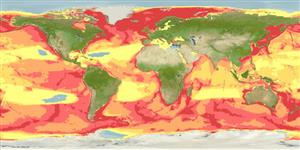Common names from other countries
Environment: milieu / climate zone / depth range / distribution range
Ecología
; salobre; rango de profundidad 0 - 732 m (Ref. 116169). Tropical; 90°N - 90°S, 180°W - 180°E
Circumglobal: Balaenoptera acutorostrata acutorostrata: North Atlantic; Balaenoptera acutorostrata scammoni: North Pacific (Ref. 1522).
Length at first maturity / Tamaño / Peso / Age
Maturity: Lm ? range ? - ? cm Max length : 1,070 cm TL macho / no sexado; (Ref. 1394); 1070 cm TL (female); peso máximo publicado: 14.0 t (Ref. 1394)
Distributed from the tropics to the ice edges in both hemispheres. They can be seen offshore, and more often in coastal and inshore areas. They are rarely seen in some tropical pelagic areas. Minimum depth from the Pacific (Ref. 83490) and maximum depth based from their food in the Atlantic (Ref. 83488). Feeds on krill and small schooling fishes (Ref. 1394). Oceanodromous (Ref. 75906). Distributed from the tropics to the ice edges in both hemispheres. They can be seen offshore, and more often in coastal and inshore areas. They are rarely seen in some tropical pelagic areas (Ref. 1394). They are known to be 'gulpers,' feeding in separate events, often lunging at large schools of fish (Ref. 122680). Also feeds on krill (Ref. 1394). Oceanodromous (Ref. 75906).
Jefferson, T.A., S. Leatherwood and M.A. Webber. 1993. (Ref. 1394)
IUCN Red List Status (Ref. 130435)
CITES status (Ref. 108899)
Not Evaluated
Human uses
Pesquerías: comercial
FAO - pesquerías: landings, species profile | FishSource | Sea Around Us
Herramientas
Fuentes de Internet
Estimates based on models
Preferred temperature
(Ref.
115969): 0.2 - 11.2, mean 2.9 (based on 10218 cells).
Resiliencia
Medio, población duplicada en un tiempo mínimo de 1.4-4.4 años (K=0.17; tm=8).
Vulnerability
High vulnerability (63 of 100).
Price category
Unknown.
